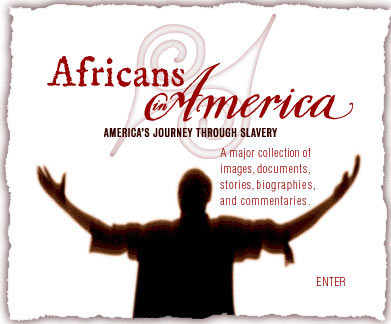talking history | syllabi | students | teachers | puzzle | about us
Africans in America
http://www.pbs.org/wgbh/aia
Created and maintained by the WGBH Educational Foundation (copyright 1998, 1999).
Reviewed Fall 2000.
Writing two hundred years after Prince Hall and other black Bostonians petitioned the Massachusetts General Court, Nathan Huggins argued that “however much black and white, slave and free seem to be polar opposites, we must see them not only as interdependent, but as having a common story and necessarily sharing the same fate” (Black Odyssey, 1977). This imperative to illuminate the shared history of slavery and freedom informs the Africans in America project. This ambitious enterprise, supported by substantive funding from government and corporate sponsors, includes a Web site, a six-hour public television series, and related materials.
A hybrid site, Africans in America is an extensive electronic exhibition, an enormous archive of well-known and rarely seen primary materials, and a prodigious teaching resource. What does the digital presentation of the history of racial slavery from “the start of the Atlantic slave trade in the sixteenth century to the end of the American Civil War in 1865” provide that other historical work does not? What narrative line can Africans in America offer young people, for example, that cannot be found in the Young Oxford History of African Americans series (edited by Robin D. G. Kelley and Earl Lewis, 1995–1997)? The Web site, like the companion documentary, is divided into four distinct but overlapping chronological periods: part 1, “The Terrible Transformation (1450–1750)”; part 2, “Revolution (1750–1805)”; part 3, “Brotherly Love (1791–1831)”; and part 4, “Judgment Day (1831–1865).” Despite brief mentions of Prince Henry the Navigator and Elmina Castle in part 1, the story of slavery in British America really begins, not with the “first passage,” but with the arrival of Africans in Jamestown in 1619. (See Colin Palmer, The First Passage, 1995.) Read against the Web-mounted narrative of the Civil War and Emancipation furnished by the Freedmen and Southern Society Project, the “end” of the story of slavery in America is also strangely truncated. (See Freedmen and Southern Society Project, University of Maryland, College Park .)
Obviously, the Web site cannot provide the depth of analytical arguments provided by scholarly monographs. Nor can this electronic exhibition supply the tactile apprehension that museum exhibitions such as Mystic Seaport’s “Amistad: Voyage to Freedom” offer. (See http://amistad.mysticseaport.org/forum/links/voyage.to.freedom.html>.) Fortuitously, however, the easy-to-navigate site, organized around multiple entry points, prompts viewers to pose substantive queries and to construct their own stories. First, the “Narrative” sections provide brief introductions to each chronological period. Second, the invaluable “Resource Bank” profiles significant “People and Events,” while the list of “Historical Documents” includes an extraordinarily rich array of images and printed texts. Third, a gallery of “Modern Voices,” arranged in an accessible question-and-answer format, features historians and other scholars who provide concise elaborations of America’s journey through slavery. Thus, the handy site index enables viewers to investigate specific topics and time periods or to construct their own paths of inquiry.
The Africans in America project was deliberately designed “to help to inform and inspire young people” and to encourage them to use historical materials “to articulate current struggles and tensions and thus create a common future” (Africans in America Teacher’s Guide, 1998). Presumably, teachers across the country have been using the site resources and the related material in the Web-mounted “Teacher’s Guide” to create engaging and effective lessons for our nation’s youth. Creating a link on the site for a “teacher’s corner” would allow users to share ideas for lesson plans and to showcase student projects. This addition would transform a stupendous but static site into an interactive forum where students, teachers, and scholars could deliberate the multiple and ongoing struggles over the meaning of freedom.
Tracey Weis
Millersville University
Millersville, Pennsylvania

